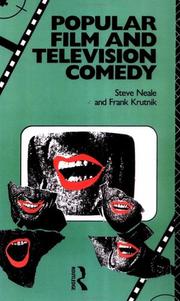Check nearby libraries
Buy this book

"How is comedy related to its institutional context? Neale and Krutnik, in this wide-ranging discussion of the genre, propose that comedy always involves deviation from aesthetic and cultural conventions and norms"--Publisher description.
Check nearby libraries
Buy this book

Previews available in: English
Subjects
Comedy films, History, History and criticism, Media Studies, Nonfiction, Television comedies, The Comic, Films comiques, Histoire et critique, Émissions comiques, Histoire, Télévision, Comique, Comédies télévisées, PERFORMING ARTS, Film & Video, Reference, Filmkomödie, Fernsehkomödie, Komische films, Humor (grappigheden), Televisie, Film, Comic, the| Edition | Availability |
|---|---|
|
1
Popular Film and Television Comedy
2002, Taylor & Francis Inc
Electronic resource
in English
0203131975 9780203131978
|
zzzz
|
| 2 |
aaaa
|
Book Details
Edition Notes
Includes bibliographical references (p. 262-277) and index.
Classifications
The Physical Object
Edition Identifiers
Work Identifiers
Source records
Scriblio MARC recordLibrary of Congress MARC record
Library of Congress MARC record
Internet Archive item record
amazon.com record
Internet Archive item record
Better World Books record
Better World Books record
Library of Congress MARC record
marc_columbia MARC record
ISBNdb
marc_columbia MARC record
harvard_bibliographic_metadata record
Work Description
Steve Neale and Frank Krutnik take as their starting point the remarkable diversity of comedy's forms and modes - feature-length narratives, sketches and shorts, sit-com and variety, slapstick and romance. Relating this diversity to the variety of comedy's basic conventions - from happy endings to the presence of gags and the involvement of humour and laughter - they seek both to explain the nature of these forms and conventions and to relate them to their institutional contexts. They propose that all forms and modes of the comic involve deviations from aesthetic and cultural conventions and norms, and, to demonstrate this, they discuss a wide range of programmes and films, from Blackadder to Bringing up Baby, from City Limits to Blind Date, from the Roadrunner cartoons to Bless this House and The Two Ronnies. Comedies looked at in particular detail include: the classic slapstick films of Keaton, Lloyd, and Chaplin; Hollywood's 'screwball' comedies of the 1930s and 1940s; Monty Python, Hancock, and Steptoe and Son. The authors also relate their discussion to radio comedy.
Community Reviews (0)
History
- Created April 1, 2008
- 19 revisions
Wikipedia citation
×CloseCopy and paste this code into your Wikipedia page. Need help?
| March 12, 2025 | Edited by MARC Bot | import existing book |
| July 26, 2024 | Edited by MARC Bot | import existing book |
| December 19, 2023 | Edited by ImportBot | import existing book |
| December 16, 2022 | Edited by MARC Bot | import existing book |
| April 1, 2008 | Created by an anonymous user | Imported from Scriblio MARC record |










